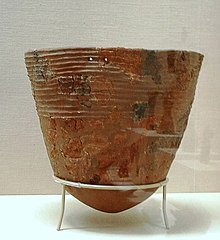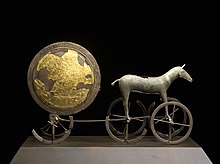යුගත්ර න්යාය
Appearance
(Three-age system වෙතින් යළි-යොමු කරන ලදි)



Nahal Hever Canyon, Israel Museum, Jerusalem
යුගත්ර න්යාය (ඉංග්රීසි: three-age system) යනු සී. ජේ. තොම්සන් විසින් ඉදිරිපත් කළ න්යායය කි.[1] එහි දී මානව ප්රාග් ඉතිහාසය, ශිලා යුගය, ලොකඩ යුගය, සහ යකඩ යුගය,[2][3] ලෙස යුග ත්රිත්වයකට බෙදා දක්වයි.
යුගත්ර න්යාය සාරාංශ වගුව
[සංස්කරණය]| යුගය | කාලපරිච්ඡේදය | මෙවලම් | ආර්ථිකය | වාසස්ථාන | සමාජය | ආගම් |
|---|---|---|---|---|---|---|
| ශිලා යුගය (3.4 mya – 2000 BC) |
Paleolithic | Handmade tools and objects found in nature – cudgel, club, sharpened stone, chopper, handaxe, scraper, spear, harpoon, needle, scratch awl. In general stone tools of Modes I–IV. | Hunting and gathering | Mobile lifestyle – caves, huts, tusk/bone or skin hovels, mostly by rivers and lakes |
A band of edible-plant gatherers and hunters (25–100 people) | Evidence for belief in the afterlife first appears in the Upper Palaeolithic, marked by the appearance of burial rituals and ancestor worship. Shamans, priests and sanctuary servants appear in the prehistory. |
| Mesolithic (other name epipalaeolithic) | Mode V tools employed in composite devices – harpoon, bow and arrow. Other devices such as fishing baskets, boats | Intensive hunting and gathering, porting of wild animals and seeds of wild plants for domestic use and planting | Temporary villages at opportune locations for economic activities | Tribes and bands | ||
| Neolithic | Polished stone tools, devices useful in subsistence farming and defense – chisel, hoe, plough, yoke, reaping-hook, grain pourer, loom, earthenware (pottery) and weapons | Neolithic Revolution – domestication of plants and animals used in agriculture and herding, supplementary gathering, hunting, and fishing. Warfare. | Permanent settlements varying in size from villages to walled cities, public works. | Tribes and formation of chiefdoms in some Neolithic societies the end of the period | Polytheism, sometimes presided over by the mother goddess, shamanism | |
| ලෝකඩ යුගය (3300 – 1200 BC) |
තඹ යුගය (Chalcolithic) |
තඹ මෙවලම්, කුඹල් සක | Civilization, including craft, trade | Urban centers surrounded by politically attached communities | City-states* | Ethnic gods, state religion |
| ලෝකඩ යුගය | ලෝකඩ මෙවලම් | |||||
| යකඩ යුගය (1200 – 550 BC) |
යකඩ මෙවලම් | Includes trade and much specialization; often taxes | Includes towns or even large cities, connected by roads | Large tribes, kingdoms, empires | One or more religions sanctioned by the state | |
* Formation of states starts during the Early Bronze Age in Egypt and Mesopotamia and during the Late Bronze Age first empires are founded.
අමතර අවධානයට
[සංස්කරණය]මූලාශ්ර
[සංස්කරණය]- ^ "දෙවන සමාසික පරීක්ෂණය - 2017 මාර්තු" (PDF). රුහුණු විශ්වවිද්යාලය. සම්ප්රවේශය 2024-04-26.
- ^ Kipfer, Barbara Ann (30 April 2000). Encyclopedic Dictionary of Archaeology. New York: Springer Science & Business Media (published 2000). p. 564. ISBN 9780306461583. සම්ප්රවේශය 29 January 2021.
Three-Age system: The division of human prehistory into three successive stages - Stone Age, Bronze Age, and Iron Age - based on the main type of material used in tools of the period. [...] The Ages are only developmental stages, and some areas skipped one or more of the stages. At first entirely hypothetical, these divisions were later confirmed by archaeological observations.
- ^ Darvill, Timothy (2021-08-19), "Three Age System" (in en), The Concise Oxford Dictionary of Archaeology (Oxford University Press), , , https://www.oxfordreference.com/view/10.1093/acref/9780191842788.001.0001/acref-9780191842788-e-4253, ප්රතිෂ්ඨාපනය 2022-03-09
භාහිර සබැඳි
[සංස්කරණය]- Human Timeline (Interactive) – Smithsonian, National Museum of Natural History (August 2016).
